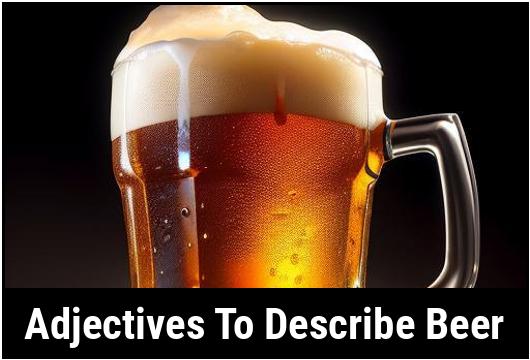- You are here:
- Home »
- adjectives
- » 31 Adjectives To Describe Beer

31 Adjectives To Describe Beer
Beer tasting is an art form that involves savoring the complex flavors and aromas of different brews. When trying to articulate the characteristics of a beer, using adjectives to describe it can be incredibly helpful. Whether you are a beer enthusiast, a brewer, or simply someone who appreciates a good beer, having a vocabulary of descriptive adjectives at your disposal can enhance your ability to communicate about the beers you enjoy. This article will explore the importance of using adjectives to describe beer, how to choose the right adjectives, the types of adjectives to use, and why they are valuable for the beer tasting experience.
Key Takeaways
- Adjectives are essential for articulating the unique qualities, flavors, and aromas found in different beers.
- Using descriptive adjectives can enhance communication and understanding among beer enthusiasts and professionals.
- Adjectives assist in creating a more comprehensive and detailed understanding of beer characteristics.
Adjectives To Describe Beer
1. Refreshing
One of the most commonly used adjectives to describe beer is "refreshing." A cold and crisp beer can quench your thirst on a hot summer day, leaving you feeling revitalized and satisfied. The effervescence and lightness of certain beers contribute to their refreshing nature.
2. Crisp
When a beer is described as "crisp," it refers to its clean and sharp taste. Beers that are not heavy or overly malty often fall into this category. A crisp beer can be incredibly satisfying, especially when paired with a delicious meal.
3. Malty
Malt is a key ingredient in brewing and can greatly impact the flavor profile of a beer. Beers that are described as "malty" often have a rich, sweet, and sometimes caramel-like taste. These beers can provide a comforting and warming sensation.
4. Hoppy
"Hoppy" is a term typically associated with beer styles like India Pale Ales (IPAs). Hops contribute bitterness, aroma, and flavor to beer. A hoppy beer can have obvious hop presence, which can range from floral and citrusy to piney and resinous, adding a distinct character to the brew.
5. Bitter
Bitterness is a common characteristic in certain beer styles, such as IPAs or stouts. Some beer drinkers specifically seek out bitter flavors, considering them an integral part of the tasting experience. A beer described as "bitter" can have a pleasantly sharp or lingering taste.
6. Smooth
A smooth beer is one that goes down effortlessly, with a velvety texture and no harsh edges. These beers are often well-balanced and easy to drink. Many popular lagers and ales fall into this category.
7. Hoppy
As mentioned earlier, "hoppy" refers to the presence of hops in a beer. This adjective can encompass various characteristics, including bitterness, aroma, and flavor. Hoppy beers can be bold, complex, and immensely enjoyable for those who appreciate the unique qualities of hops.
8. Fruity
Fruit flavors are sometimes intentionally incorporated into beers, resulting in deliciously fruity brews. Whether it is the use of real fruit or the manipulation of yeast strains, a fruity beer can offer a delightful range of flavors, from tropical to citrusy to berry-infused.
9. Spicy
Some beers feature spices as a prominent flavor component. These spices can include anything from coriander and cloves to cinnamon and nutmeg. A spicy beer can provide a warm and aromatic experience, reminiscent of holiday seasons.
10. Earthy
Beers that are described as "earthy" often have flavors that remind one of the natural world. Earthy tones can arise from ingredients like hops, yeast strains, or even additional elements such as barrel aging. These types of beers can have a rustic and grounded character.
11. Rich
A rich beer is one that boasts a full-bodied and luxurious mouthfeel. These beers are often higher in alcohol content and can offer a range of flavors that dance on the tongue. They can be indulgent and perfect for savoring during special occasions.
12. Creamy
When a beer is described as "creamy," it means it has a smooth and velvety texture. This adjective is often used to depict beers like stouts or nitro beers that are served with a creamy head. The creaminess adds a luxurious element to the overall drinking experience.
13. Robust
A robust beer is one that is full of flavor, intensity, and complexity. These beers often have a strong presence of malt or hops, or both, providing a bolder and more pronounced taste than their lighter counterparts. A robust beer can be quite satisfying, leaving a lasting impression on the palate.
14. Balanced
When a beer is referred to as "balanced," it means that its different elements, such as malt sweetness and hop bitterness, work harmoniously together. This creates a well-rounded and enjoyable drinking experience where no single flavor dominates. Balanced beers are often easy to pair with various types of food.
15. Lively
Describing a beer as "lively" refers to its sparkling or effervescent quality. These beers can be highly carbonated, with bubbles dancing in the glass, enhancing the overall experience. The liveliness adds a touch of vibrancy to the beer, making it more engaging to drink.
16. Complex
Complex beers offer a multitude of flavors and aromas that evolve and intermingle as you drink them. These beers often have several layers of taste, contributing to an exciting and rewarding drinking experience. Exploring the complexity of a beer can be akin to a journey of delightful discovery.
17. Satisfying
A satisfying beer is one that leaves you feeling content and fulfilled. It can be due to its rich flavor, refreshing qualities, or the sheer enjoyment it provides to your taste buds. Savoring a satisfying beer can be a gratifying experience, leaving a lasting memory of enjoyment.
18. Aromatic
Beer can be incredibly aromatic, captivating your senses with its enticing scents. Aromas can range from floral and fruity to spicy or even reminiscent of freshly baked bread. The aromatic qualities of a beer can greatly enhance the overall tasting experience.
19. Herbal
A herbal beer is one that features the flavors and aromas of various herbs and botanicals. These flavors can add uniqueness and depth to the brew, elevating it beyond traditional beer profiles. Herbal beers can be an intriguing departure from more typical varieties.
20. Clean
When a beer is described as "clean," it means that it has a crisp and pure taste with no off-flavors or lingering aftertastes. Clean beers are well-crafted and showcase the skill of the brewer in achieving a flawlessly executed beverage.
21. Robust
A robust beer is one that is full of flavor, intensity, and complexity. These beers often have a strong presence of malt or hops, or both, providing a bolder and more pronounced taste than their lighter counterparts. A robust beer can be quite satisfying, leaving a lasting impression on the palate.
22. Zesty
Zesty beers offer a vibrant and invigorating experience. These beers can be characterized by their lively carbonation, bright and tangy flavors, or the inclusion of ingredients like citrus fruits or spices. A zesty beer can uplift your spirits and bring a joyful zing to your taste buds.
23. Delicate
A delicate beer is one that is subtly nuanced and refined. These beers often have more fragile flavors that require attention to fully appreciate. A delicate beer can be a welcome change of pace for those seeking a more intricate and restrained drinking experience.
24. Robust
A robust beer is one that is full of flavor, intensity, and complexity. These beers often have a strong presence of malt or hops, or both, providing a bolder and more pronounced taste than their lighter counterparts. A robust beer can be quite satisfying, leaving a lasting impression on the palate.
25. Silky
A silky beer has a smooth and velvety mouthfeel that glides effortlessly across the palate. These beers often have a luxurious texture that adds another layer of enjoyment to the drinking experience. Silky beers can be indulgent treats that are delightful to savor slowly.
26. Bright
When a beer is described as "bright," it means that it has a lively and vibrant flavor profile. Bright beers can be characterized by their fresh and invigorating qualities, making them perfect for those seeking a zesty and uplifting drinking experience.
27. Well-crafted
A well-crafted beer is one that is expertly brewed with attention to detail. These beers showcase the skill and dedication of the brewer, resulting in a superior product. Well-crafted beers often demonstrate balance, complexity, and excellent flavor integration.
28. Unique
Unique beers are those that stand out from the crowd, offering something truly distinctive and remarkable. These beers can push the boundaries of traditional brewing styles, incorporating unusual ingredients or experimenting with innovative techniques. Each sip of a unique beer can be an adventure in itself.
29. Juicy
The term "juicy" is often associated with hop-forward beers, particularly New England IPAs. These beers feature a juicy and fruity flavor profile, with hop flavors that evoke images of tropical fruits or citrus groves. A juicy beer can be a delightfully refreshing and vibrant choice.
30. Elegant
An elegant beer is one that is distinguished and refined, with a sense of grace and sophistication. These beers often excel in their simplicity and balance, bringing together subtle flavors and aromas to create a harmonious and enjoyable drinking experience.
31. Exciting
Last but not least, beer can be exciting. Trying different styles, exploring new breweries, and discovering unique flavors can be a thrilling journey. The world of beer is constantly evolving, and there is always something new and exciting to experience.
Why Use Adjectives To Describe Beer
The use of adjectives to describe beer serves several important purposes. Firstly, it allows for a more nuanced and detailed understanding of the beer being discussed. Different beers can possess a wide variety of flavors, aromas, and textures, and using adjectives helps to accurately convey these characteristics. Moreover, when individuals share their experiences with a particular beer, the use of adjectives can help others to visualize and understand the beer’s attributes, fostering a more comprehensive dialogue within the beer community.
Using adjectives also enables brewers to receive valuable feedback on their beers, allowing them to better understand how their creations are being perceived and appreciated by consumers. It can also assist beer aficionados in making informed decisions about which beers to try based on their individual preferences.
How To Choose The Right Adjectives To Describe Beer
Selecting the appropriate adjectives to describe beer requires a keen understanding of the various characteristics that can be found in different styles of beer. When choosing adjectives, consider factors such as aroma, taste, mouthfeel, appearance, and overall impression.
It’s important to use adjectives that accurately reflect the specific qualities of the beer being described. For example, rather than simply saying a beer is "good" or "bad," using adjectives that pinpoint the precise flavors or aromas such as "citrusy," "caramel-like," or "biscuity" provides a more descriptive and informative portrayal of the beer.
Consider the intensity of the adjective as well. Some beers may possess subtle, delicate flavors, while others may be bold and robust. Matching the intensity of the adjective to the intensity of the beer’s characteristics can enhance the accuracy and effectiveness of the description.
Types Of Adjectives For Describing Beer
Aroma Adjectives
A beer’s aroma is often the first sensory aspect encountered. Describing a beer’s aroma can involve adjectives that convey qualities such as fruity, floral, hoppy, spicy, malty, toasty, earthy, herbal, citrusy, piney, or resinous. These descriptive terms help to paint a vivid picture of the scent that greets the drinker.
Flavor Adjectives
When it comes to flavor, a diverse range of adjectives can be utilized to effectively convey the taste experience. Some examples of flavor adjectives include bitter, sweet, sour, tangy, malty, hoppy, fruity, spicy, roasty, nutty, caramelized, chocolatey, toasty, and herbal. These adjectives can help to encapsulate the diverse and rich flavor profiles found in various beers.
Mouthfeel Adjectives
Mouthfeel refers to the tactile sensations experienced in the mouth when drinking beer. Adjectives such as creamy, smooth, velvety, effervescent, crisp, full-bodied, thin, chewy, astringent, or warming can provide insight into the texture and sensation of the beer in the mouth.
Appearance Adjectives
The visual presentation of a beer can also be described using adjectives that convey its appearance. Terms like clear, hazy, cloudy, amber, golden, coppery, opaque, frothy, creamy, lacy, and persistent can be employed to characterize the beer’s visual qualities.
Overall Impression Adjectives
In addition to describing specific attributes, it can be helpful to use adjectives that encapsulate the overall impression a beer leaves. Adjectives such as balanced, complex, refreshing, robust, delicate, nuanced, assertive, harmonious, satisfying, and intriguing can summarize the overall character of the beer.
In the world of beer, the use of adjectives to describe its diverse qualities is indispensable. From capturing the nuances of flavor and aroma to conveying the visual and tactile components, adjectives are instrumental in articulating the multi-dimensional experience of enjoying a good beer. Continued cultivation and expansion of one’s vocabulary of descriptive adjectives can lead to a deeper, more sophisticated appreciation and understanding of beer, and foster a rich and vibrant discourse within the beer community. By recognizing the significance of using adjectives to describe beer, enthusiasts and professionals alike can elevate their beer tasting experiences and effectively communicate the richness of the brews they encounter.
Examples Of Adjectives For Different Types Of Beer
When it comes to describing beer, adjectives play a crucial role in articulating its various attributes and characteristics. Whether you are a beer connoisseur, a brewer, or simply someone looking to expand your beer vocabulary, having a diverse range of adjectives at your disposal can help you express your thoughts and experiences more effectively.
-
Crisp – This adjective is often associated with light and refreshing beers that have a clean and sharp taste. It is commonly used to describe lagers and pilsners.
Example: "The crisp lager had a refreshing bite and a smooth finish."
-
Hoppy – Hoppy beers have a distinct bitterness and aroma derived from the use of hops during brewing. This adjective is commonly used for India Pale Ales (IPAs) and other hop-forward beer styles.
Example: "The hoppy IPA had a strong citrusy aroma and a lingering bitterness."
-
Malty – Malty beers have a rich, sweet, and sometimes caramel-like flavor profile. They tend to have a higher malt presence and can be seen in beer styles such as Scotch ales and bocks.
Example: "The malty Scotch ale had a deep amber color and a smooth, caramel-forward taste."
-
Citrusy – This adjective is used to describe beers that have prominent citrus flavors, often derived from hops or adjuncts like orange peels. It is commonly associated with pale ales and certain wheat beer styles.
Example: "The citrusy wheat beer had a refreshing blend of orange and lemon notes."
-
Roasty – Roasty beers, like stouts and porters, have a distinct roasted flavor reminiscent of coffee, chocolate, or dark bread. This adjective is often used to describe the depth and complexity of these dark beer styles.
Example: "The roasty porter had a rich chocolate aroma and a velvety smooth texture."
-
Sour – Sour beers, as the name implies, have a tangy and acidic taste profile. They are often tart and can be quite complex, with flavors ranging from fruity to funky. Lambics and Berliner Weisses are examples of sour beer styles.
Example: "The sour lambic had a pronounced acidity and hints of cherries and oak."
-
Spicy – Beers that have a noticeable spiciness, often derived from the use of certain yeast strains or added spices, fall into this category. Belgian ales and farmhouse saisons are known for their spicy character.
Example: "The spicy saison had a distinctive peppery note and a hint of clove."
-
Effervescent – This adjective refers to beers with a lively and spirited carbonation that creates a pleasant tingling sensation on the palate. It is often associated with Belgian-style beers, particularly saisons and tripels.
Example: "The effervescent tripel had a champagne-like fizziness and a subtle fruitiness."
-
Full-bodied – Full-bodied beers have a rich and substantial mouthfeel, often accompanied by a higher alcohol content. They can be smooth and satisfying, ideal for savoring and slowly enjoying. Examples of full-bodied beers include imperial stouts and barleywines.
Example: "The full-bodied imperial stout had a thick, velvety texture and a warming alcohol presence."
-
Caramel – This adjective is used to describe beers with a prominent caramel flavor and aroma. It is often found in amber ales, Oktoberfest beers, and certain brown ales.
Example: "The caramel amber ale had a sweet and toasty malt backbone."
Common Mistakes In Using Adjectives To Describe Beer
While using adjectives to describe beer can enhance your communication and appreciation of the beverage, there are some common mistakes to avoid. These mistakes can lead to misinterpretation or confusion among beer enthusiasts or professionals. Here are a few to keep in mind:
-
Overgeneralization: Avoid using vague and generic adjectives that do not provide specific details about the beer. Instead, be precise and use adjectives that accurately describe its taste, aroma, appearance, and mouthfeel.
-
Misleading associations: Some adjectives may carry different meanings in beer descriptions compared to other contexts. For example, "skunky" is often used to describe beers that have been affected by exposure to light, creating an undesirable aroma. Avoid using adjectives that can confuse or mislead others.
-
Neglecting balance: While it is essential to highlight specific characteristics, be mindful not to focus solely on one aspect of the beer. Remember that balance is crucial, and it is important to consider the overall experience when using adjectives to describe beer.
-
Ignoring individual preferences: Taste perception is subjective, and what may be appealing to one person may not be the same for another. When describing beer, avoid absolute statements and recognize that personal preferences can influence the interpretation and usage of adjectives.
-
Lack of context: Adjectives should be used in the appropriate context to effectively describe the beer. Consider the specific beer style, ingredients used, and overall brewing process to provide accurate and informative descriptions.
By avoiding these common mistakes, you can ensure that your beer descriptions are clear, informative, and meaningful to others.
Using Adjectives Effectively
To use adjectives effectively when describing beer, consider the following tips:
-
Be specific: Use adjectives that accurately convey the beer’s unique qualities. Instead of saying a beer is simply "good" or "bad," try to identify specific flavors, aromas, or textures that contribute to your overall impression.
-
Provide context: When describing beer, consider the relevant details such as the beer style, ingredients used, and brewing techniques employed. This information helps others understand the intended characteristics of the beer and can provide a more comprehensive description.
-
Compare and contrast: Use adjectives to draw comparisons and highlight contrasts between different beers or beer styles. This approach can help others understand the relative attributes and differences between each beer.
-
Consider the experience: Reflect on your overall experience with the beer when selecting adjectives. Consider its appearance, aroma, taste, mouthfeel, and finish. Providing a well-rounded description helps paint a complete picture for others.
-
Practice sensory evaluation: To broaden your beer vocabulary and improve your ability to describe beer, engage in sensory evaluation exercises. Train your taste buds and olfactory senses by tasting different beer styles and actively identifying and articulating their specific attributes.
Exercises And Practice
To strengthen your ability to describe beer using adjectives, try the following exercises:
Exercise 1:
Select a beer style of your choice and write a detailed description of its appearance, aroma, taste, and mouthfeel. Use at least five different adjectives for each category. Compare your description to the official style guidelines to ensure accuracy.
Exercise 2:
Organize a beer tasting session with friends or colleagues. Take turns describing each beer using specific adjectives to highlight its unique characteristics. Discuss and compare your descriptions to deepen your understanding of different beer styles.
Exercise 3:
Engage in a blind tasting challenge where you evaluate and describe beers without knowing their specific style or brand. Use a wide range of adjectives to describe each beer and try to identify specific flavors and aromas. Compare your descriptions and predictions to reveal the beer’s true identity.
Conclusion
Adjectives are powerful tools for describing beer in a detailed and meaningful way. By effectively using adjectives, you can enhance your own appreciation and understanding of beer, as well as communicate your experiences to others accurately. Consider the specific attributes and characteristics of each beer style and employ adjectives that help paint a vivid picture of its appearance, aroma, taste, and mouthfeel. With practice and a diverse beer vocabulary, you can confidently navigate the world of beer and describe its infinite possibilities. So go ahead, grab a beer, and start exploring the wonderful world of adjectives that enhance your beer conversations!
FAQS On Adjectives To Describe Beer
What Are Some Common Adjectives Used To Describe Beer?
Some common adjectives used to describe beer include crisp, hoppy, malty, refreshing, and robust.
What Does It Mean For A Beer To Be Considered "crisp"?
A crisp beer typically has a light and refreshing taste, with a dry finish and a clean mouthfeel. It is often described as being clear and bright, with a sharp and lively flavor.
Can You Explain The Term "hoppy" In Relation To Beer?
Hoppy refers to the flavors and aromas derived from the hops used in the brewing process. These flavors can range from piney and citrusy to floral and herbal, and are often associated with bitterness and a slightly dry finish.
What Qualities Make A Beer "malty"?
A malty beer typically has a rich and full-bodied taste, with a sweet or caramel-like flavor profile. This is achieved through the use of malts, which are grains that have been sprouted, roasted, and kilned to give the beer a sweet and nutty taste.
How Would You Describe A Beer That Is Considered "robust"?
A robust beer is one that is bold and flavorful, often with a higher alcohol content and a full-bodied mouthfeel. These beers can range from rich and malty to intense and complex, with a strong and lingering aftertaste.








